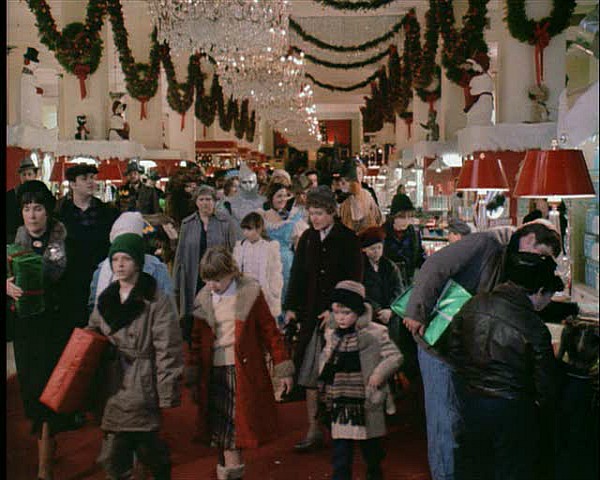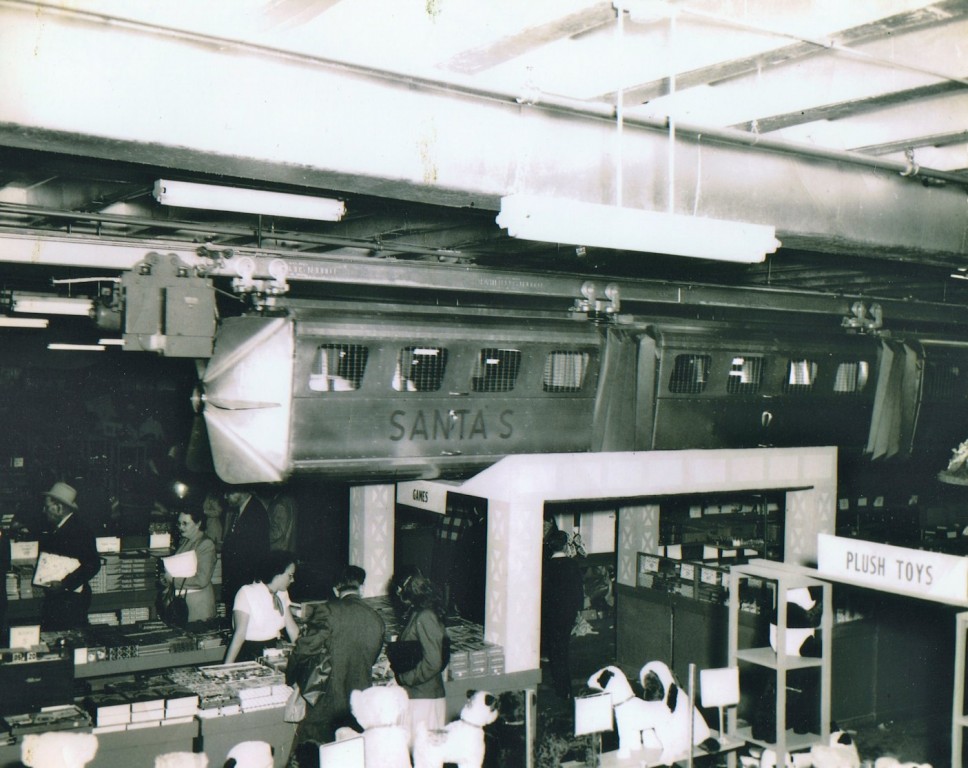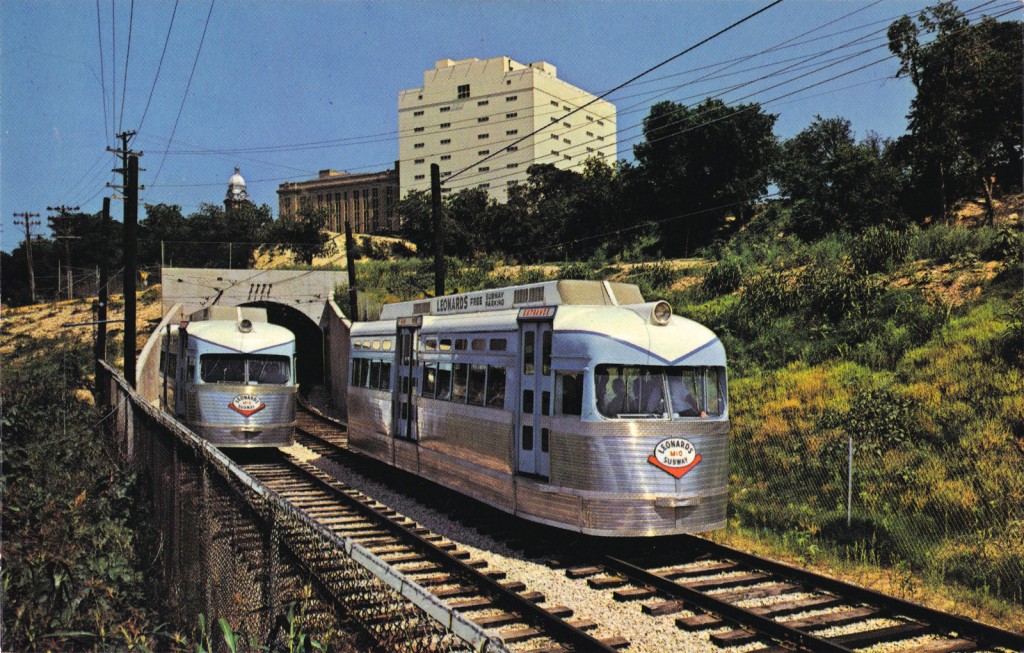Higbee's, Cleveland, Ohio.

|




|
Higbee's, Cleveland, Ohio.

Higbee's a la Christmas Story...


Your last three posts with pics showed up cool. Maybe OGR a has a ghost on their web site. Scary!!!!!!! Yes I typing from my laptop not the tablet.
It was just that one group of photos, everything else that you posted earlier came through just fine, as did this last group. BTW, thanks for posting these, it would make a neat book.
Let's see if this one shows up:
Leonard's Department Store, Fort Worth, Texas.

Jon:
Yep, it showed up.
Leonard’s is well-known among us Trolley buffs, too, as they had their own fleet of specially-designed full-sized PCC trolley cars to shuttle shoppers the 7/10th of a mile from their parking lot to the store.
Bill
Thanks for the confirmation, Bill. Is this the trolley?

Thanks for the confirmation, Bill. Is this the trolley?

Jon:
Yes, that’s it, although it’s hard to tell it’s a PCC from that angle. Attached is another photo from a different angle in which it more closely resembles a conventional PCC.
Thanks to Don Ross for that photo.
Bill
Thanks for the confirmation, Bill. Is this the trolley?

Jon:
Yes, that’s it, although it’s hard to tell it’s a PCC from that angle. Attached is another photo from a different angle in which it more closely resembles a conventional PCC.
Thanks to Don Ross for that photo.
Bill
From the side it resembles the CTA 6000 series EL cars not so much the PCCs The front resembles the North Shore Electroliners.

From the side it resembles the CTA 6000 series EL cars not so much the PCCs The front resembles the North Shore Electroliners.
Good observation, but they were used PCCs purchased from the Washington, DC transit system and then significantly modified them for their unique requirements.
Bill

1963

These trolleys appear to be double enders, able to run either direction, no turning back loops.
1963

Now those two look more like PCC from the front.
Good observation, but they were used PCCs purchased from the Washington, DC transit system and then significantly modified them for their unique requirements.
Bill
Bill, Although the intial production of the CTA 6000 series by St Louis Car Company used PCC components, the first 200 were built using new parts. 6000-6200
The second order 6201 - 6720 and 1-50 were built from components from the PCCs( new body shell, reconditioned motors trucks,control, motor generators and certain body components.

Jeez we just sure don't know how to do Christmas anymore.
that's the truth! Looking at all these wonderful department store pics, I really feel cheated!
Lazarus Department Store, Columbus, OH, 1950

Lazarus Department Store, Columbus, OH, 1950

Pretty good layout for a department store, including a decent sized yard.
These trolleys appear to be double enders, able to run either direction, no turning back loops.
Sam,
That's correct as converting those DC Transit PCC cars from single-ended to double-ended was one of those major modifications made by Leonard's.
Bill
I am a little envious of you guys/gals that grew up during this era. Being able to go to department stores in the 1950's and seeing this stuff. Due to my age, I can remember seeing layouts at some stores for about 2 holiday seasons before it became a thing of the past. And probably like many of you, I never got to stay long enough to watch the trains.
I am a little envious of you guys/gals that grew up during this era. Being able to go to department stores in the 1950's and seeing this stuff. Due to my age, I can remember seeing layouts at some stores for about 2 holiday seasons before it became a thing of the past. And probably like many of you, I never got to stay long enough to watch the trains.
Some of us grew up in the 60s and 70s when kids were still able to be kids.
>Some of us grew up in the 60s and 70s when kids were still able to be kids.
That is the truth.
Lazarus used to cover the entire front of the store with a six-story Christmas tree done in lights. Even the little stores around here turned unused space into Toyland.
I've thought a lot about this, though: when we were kids, the Christmas decorations went up after Thanksgiving. That's also when we started practicing for school pageants and helping our moms bake. When we got to go to the department stores, we got to see Santa and walk through the toy department, but if you look at one of those old buildings and realize what we were looking at, no wonder we didn't have as many meltdowns as you see now. The G.C. Murphy Toyland looked huge. It was actually two aisles in a store the size of a modern Family Dollar/Dollar General. The book "department" was the size of a large home bookshelf. There were maybe three or four kinds of large trucks in playsets, plus a dozen or so kinds of smaller ones. If there were three or four large dolls with furniture and such, and a dozen small ones, that was still enough to set off Christmas dreaming. We didn't have miles of confusing things to choose from, and the toys didn't do things for us. When it came to trains, I think our Murphy's and Grant's had a couple of large HO sets, a couple of basic ones, and maybe a Marx set. (By the time I got around, most Lionel was at Heil's Bike Shop or Cooey-Bentz in Wheeling.) Sometimes fewer choices make for happier kids.
That's also why so many of us remember being allowed to wander around and look at toys When there were only a couple of aisles, our parents always knew where we were.
J L Hudsons was huge, I believe the downtown store was over 20 storys tall and in the 50's it was considered to be the largest department store in America. Parents did have to keep track of their kids!
J L Hudson's statistics culled from Historic Detroit.org:
For generations, it was as synonymous with Christmas and fashion as it was Detroit. The store at Woodward and Gratiot avenues was absolutely massive, evolving with the Motor City until it became the tallest department store in the world. By the time it finished growing, the store’s size almost defied belief.
A quick list of facts, many courtesy of the Detroit Historical Museum:
Joseph Lowthian Hudson and his father were running a men’s clothing store in the lumber town of Ionia, Mich., when the Panic of 1873 struck. When the sawmills were shuttered, their customers couldn’t pay their bills. Then Hudson’s father died. Three years later, Hudson went bankrupt, paying his creditors 60 cents on the dollar. Hudson dusted himself off and started over in Detroit. In 1881, Hudson opened his first store on the ground floor of the old Detroit Opera House. In 1888, he was so successful, he looked up all the creditors he had shorted in the bankruptcy proceedings 12 years earlier and paid them in full - with compound interest.
In 1911, he opened what would become the first piece of the behemoth. Many people thought Hudson was a fool opening so far north of Jefferson Avenue, then the heart of the city’s commercial district.
Hudson himself was a legend. Easily one of the most successful businessmen in the city’s history, Hudson also was a benefactor. He would serve as chairman and organizer of Detroit’s Associated Charities, which laid the foundation for the United Way Foundation.
In 1954, Hudson’s had sales of more than $163 million (an astronomical $1.28 billion today).
In 1961, at age 29, Joseph L. Hudson Jr. - the founder’s grandnephew - became the business’ president. He had started out working on the docks of the downtown store in 1950. He emphasized fashion and special events and would grow the chain, expanding into the suburbs as the city’s population sprawled into the countryside.
In 1969, Hudson’s merged with Dayton Co. of Minneapolis, creating Dayton Hudson Corp. The merger led to growth not on in Michigan, but also Ohio and Indiana.
As the city’s decline in population, reputation and wealth continued, Hudson’s downtown store closed Jan. 17, 1983, after more than 90 years of business.
But the building was not abandoned at this point. The company’s corporate offices remained in the Big Store, and about 1,200 people still worked there. A new lobby and security entrance were added on the Farmer Street side for employees and visitors. Employees would stick around the building until 1990, when the store was sold by Dayton Hudson Corp. to Southwestern Associates of Windsor, Ontario.
“Various media sources wanted the public to believe that Hudson’s had been vacant for 15 years, when in actuality, it was eight years,” said historian Michael Hauser, “which, by Detroit standards, is a relatively short period of time, compared to many other large vacant structures in the city that have been idle for decades.”
Despite several pitches to redevelop the enormous structure, the building was imploded at 5:45 p.m. (the store’s closing time) on Oct. 24, 1998.
“With a deafening roar that will echo in the hearts of Detroiters for decades, the Hudson’s building was blasted to the ground — ending one era and beginning another in 30 ground-shaking seconds,” The Detroit News wrote. “A symbol of glamor for three generations, a symbol of decay for another, the mammoth structure wobbled like a drunk, hesitated, then collapsed into a 60-foot-high pile of rubble — coating downtown streets with a fine gray dust.”
Thirteen years after the big bang at the Big Store, no development has occurred at the site other than an underground parking garage. Hope that someone might wish to build on the property has left Detroiters with nothing but a giant empty space in the heart of downtown dotted by steel girders poking above a concrete expanse.

Great stories and photos, people.
In Binghamton, NY, we had two big department stores that carried trains: Fowler, Dick & Walker displayed Lionel, and McLean's displayed American Flyer. What fun and amazement it was to stand with other kids and watch the equipment demonstrated. And we were also fortunate to have Woolworth's with its Marx trains and various HO. Sorry, no photos: Film and processing were just too expensive!
Thanks Jon for the detailed information on Hudsons. My sister and I paid a last visit in Christmas 1982, shortly before it closed. It was pretty sad.
A note about the demolition, they messed it up and dropped the building on the guideway of Detroit's automated People Mover. It was not repaired for quite a while.
The numbers are staggering. To help put Hudson's size in perspective, The Mall of America, second largest in the would, has 2,500,000 sq. ft. of floor space.

A well produced documentary of the famous Detroit department store chain from its beginning:
http://www.youtube.com/watch?v=op-KKEzh-0w

Pretty nice! The Macy's one looks like a classic department store layout of the 50's. The Sak's is very artistic, the photos look like paintings. Both very nice, too bad they don't do this anymore.
That was a pretty nice layout. Wonder what happened to it?
BTW, does Macy's still have a Christmas layout?
Yes, Macy's Herald Square's Santa Land has a Lionel layout built by TW Trainworx.
Frank,
I would say that it's a clothing store. Back in the Bronx of the 1950s, I remember similar displays outside shops along Bathgate Ave off of Claremont Parkway, a prime shopping district for surrounding neighborhoods.
Many shops displayed as much as they could outside to attract shoppers. Everyday was a sidewalk sale on Bathgate. ![]()
Jim
Hi Jim, Somebody must have been pretty adept at fishing for items at the top with a long, long pole, I'd imagine, huh. Human ingenuity- amazing.
FrankM
That's exactly how they did it, Frank. I bet there was always some grumbling from the shopkeeper when a customer asked to see the shirt on the top row. ![]()
Jim
An On30 Christmas window train display from 2009.
Access to this requires an OGR Forum Supporting Membership
